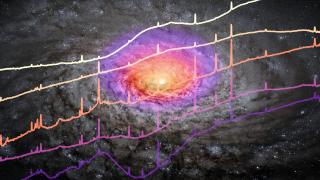Bibcode
Boecker, Alina; Alfaro-Cuello, Mayte; Neumayer, Nadine; Martín-Navarro, Ignacio; Leaman, Ryan
Bibliographical reference
The Astrophysical Journal
Advertised on:
6
2020
Journal
Citations
15
Refereed citations
15
Description
Current instruments and spectral analysis programs are now able to decompose the integrated spectrum of a stellar system into distributions of ages and metallicities. The reliability of these methods has rarely been tested on nearby systems with resolved stellar ages and metallicities. Here we derive the age-metallicity distribution of M54, the nucleus of the Sagittarius dwarf spheroidal galaxy, from its integrated Multi-Unit Spectroscopic Explorer (MUSE) spectrum. We find a dominant old (8-14 Gyr), metal-poor (-1.5 dex) component and a young (1 Gyr), metal-rich (+0.25 dex) component—consistent with the complex stellar populations measured from individual stars in the same MUSE data set. There is excellent agreement between the (mass-weighted) average age and metallicity of the resolved and integrated analyses. Differences are only 3% in age and 0.2 dex metallicity. By co-adding individual stars to create M54's integrated spectrum, we show that the recovered age-metallicity distribution is insensitive to the magnitude limit of the stars or the contribution of blue horizontal branch stars—even when including additional blue wavelength coverage from the WiFeS Atlas of Galactic Globular cluster Spectra survey. However, we find that the brightest stars can induce the spurious recovery of an old (>8 Gyr), metal-rich (+0.25 dex) stellar population, which is otherwise not expected from our understanding of chemical enrichment in M54. The overall derived stellar mass-to-light ratio of M54 is M/LV = 1.46 with a scatter of 0.22 across the field of view, which we attribute to the stochastic contribution of a young, metal-rich component. These findings provide strong evidence that complex stellar population distributions can be reliably recovered from integrated spectra of extragalactic systems.
Related projects

Nuclear Activity in Galaxies: a 3D Perspective from the Nucleus to the Outskirts
This project consists of two main research lines. First, the study of quasar-driven outflows in luminous and nearby obscured active galactic nuclei (AGN) and the impact that they have on their massive host galaxies (AGN feedback). To do so, we have been granted time with the Gran Telescopio CANARIAS (GTC) in the optical and near-infrared ranges
Cristina
Ramos Almeida